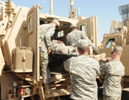
Accident Rates Dropping for Army Unit in Iraq
Increased safety emphasis by leadership in the United States Division-South serving in southern Iraq brought the average monthly accident rate down by one-third, from three per 1,000 service members to slight below two.
The U.S. Army ended FY2010 with 3,911 accidents and 505 fatalities, which were a 50 percent improvement in accidents and 2 percent drop in fatalities from the prior year. Also making safety gains was United States Division-South (USD-S), serving in southern Iraq; the unit's average monthly accident rate since spring 2010 fell by one-third from about three per 1,000 service members to just under two, Staff Sgt. Chanelcherie DeMello, USD-S PAO, reported Dec. 15.
Her report, sent from Basra, quoted USD-S Safety Director Paul Inman, who attributed the improvement to an increased emphasis on safety by leadership. "A successful safety program is based upon everyone fulfilling his or her responsibilities," said Inman. "Safety awareness events and community involvement are all good programs, but command emphasis and leader involvement is the key to a successful safety program within units."
DeMello's article said the USD-S commanding general's safety philosophy was published in February 2010 and "sets the tone for coordination and establishment of safety policies, standards and guidance for all USD-S operations and is built around the Composite Risk Management process, which is the Army’s principal risk reduction methodology." The process calls for identifying and assessing hazards, developing and implementing controls, supervising the task, and evaluating the effectiveness of the controls.
"If the CRM process is understood and used for all activities, whether in garrison or in a tactical environment, it will help in identifying and assessing hazards to help mitigate and reduce accidents across the Army," Inman said. USD-S units' command safety councils meet quarterly. Commanders may call safety stand-downs when a number of accidents occur in a short period, and these can also be scheduled as a precautionary measure, DeMello reported.